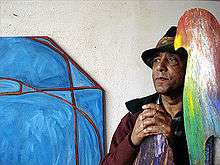Guillaume Lo-A-Njoe

Guillaume Theodoor Lo-A-Njoe (Amsterdam, June 25, 1937) is a Dutch painter of Surinamese descent.[1] Guillaume is married and has one son. He currently resides and works in Amsterdam where he celebrated his 50th anniversary as an artist in 2008.
Biography
Guillaume traces his ancenstry back to Nepal, India and China. His ancestors later came to live in Surinam, a former Dutch colony, now known as Suriname. In 1937 his parents moved to the Netherlands. Guillaume was born, in Amsterdam, the year after. He lived through the Second World War as a young child. From 1953 to 1958 Guillaume studied fine art and painting at the Amsterdam 'ḰKunstnijverheidsschool'(Artschool), a predecessor to the Gerrit Rietveld Academie.
In 1958 Guillaume received the 'Koninklijke Subsidie voor de Vrije Schilderkunst' (Royal Subsidy for Fine Art Painting) to encourage young promising artists. The same year he had his first exhibition in Café Eijlders; a large venue at the Leidseplein in Amsterdam which is famous for its artistic ambiance and clientele.
During the sixties and en seventies he made many study trips in Europe and lived in the United States and Suriname. He also travelled to India, Morocco, Mexico and the Caribbean for inspiration. Guillaume's art is present in museums worldwide; (amongst others) the Municipal Museum of Mexico City, Stedelijk Museum Amsterdam, Cobra Museum for Modern Art in Amstelveen, Gemeentemuseum Den Haag The Hague, Surinaams Museum Paramaribo, Het Curaçaosch Museum in the Dutch Caribbean and the 'Instituut Collectie Nederland', the national art collection of the state of the Netherlands.
Besides having a presence in museums Guillaume's art can be found in many private and public[2] collections worldwide and is regularly put up for auction at prestigious auction houses such as AAG (Arts & Antiques Group)[3] or Christie's[4] and Sotheby's.
Guillaume also works as commissioned artist for private and public commissions. In Amsterdam two of his commissioned artworks can be seen in public space. He designed a plaque to commemorate Surinamese nationalist and WWII resistance fighter Anton de Kom, who died in a concentration camp. The plaque was unveiled by Guillaume on November 24, 1990 at the Anton de Kom square in Amsterdam.[5] In 1991 a monument was unveiled in memory of the victims of Surinam Airways Flight 764, which crashed on June 7, 1989 during approach to Paramaribo-Zanderij International Airport, killing 176 of the 187 on board, making it the deadliest aviation disaster in Suriname's history.[6] In 2008 Guillaume celebrated his 70th birthday and his 50th anniversary as an artist. This special jubilee was enough reason for a large retrospective where he showed works spanning his entire career which still continues to date. Guillaume currently lives and works in Amsterdam Noord where he and his wife Lydia continue to receive guests and prospective clients and prepare exhibitions. A new personal website features his motto: "The beauty of a painting is that it makes no sound".
Art and Method
Inspired by COBRA (avant-garde movement) during his education and formation as an artist in the early fifties, Guillaume developed a style of expression which follows that of the Cobra movement and can be characterized by a powerful and colorful palette. His style is akin to Expressionism and can be counted to post-COBRA, where it should be noted that over the years Guillaume's art has evolved into a dynamic expressive style with his unique signature. His later oil paintings are built up from thick layers of paint, to the extent they sometimes almost become sculptural in appearance.[7] Oskar Kokoschka and Marc Chagall are among his inspirational sources. His international multi cultural background which combines Dutch, Surinamese, Indian, Nepalese and Chinese traditions also plays a role. In his work one can perceive influences of the native cultures and local nature he encountered on his travels into South America's Amazon rainforest and Asia, as can be seen for instance in his wooden totems and wooden sculptures.
Overall the artist stands in a long Dutch tradition of painters. Like the old masters, such as Rembrandt, Guillaume prepares his canvasses thoroughly before beginning actual artistic composition. Guillaume fixes his canvases on a self built wooden frame and uses selfmade tempera as a grounder and organic glue as a binder to prepare the painting surface. By this procedure the artwork is already being born bit by bit according to Guillaume's experience, which he shares on a website devoted to his 2008 jubilee exhibition.[8]
Next the oil paint is applied, which he makes from real pigments. His method of painting is direct, with emotion and temperament and full of expression.[9] When working Guillaume enters into a physical dialogue with the canvas.[10] Artworks of Guillaume include paintings, mostly oil on canvas, gouaches, wooden sculptures and objects and screen prints.[11]
References
- ↑ "G A L E R I E S.N L". galeries.nl.
- ↑ "ProfileForm Page - Kunst.nl". KunstNL.
- ↑ Margaret T., NC. "Reverse Mortgages from American Advisors Group Give You Financial Freedom". American Advisors Group.
- ↑ Christie's. "Guillaume Lo-A-Njoe (DUTCH, B. 1937)". christies.com.
- ↑ "Suriname in WW II". bevrijdingintercultureel.nl.
- ↑ http://www.buitenbeeldinbeeld.nl/Amsterdam_O/Ruyschstraat.htm
- ↑ http://www.neeltjetwiss.nl/english/collection/nieuw/exibition/Exibition.htm
- ↑ http://www.fwbk.nl/paginaguillaume/guillaume.html
- ↑ http://www.fwbk.nl/paginaguillaume/atelierfoto.html
- ↑ http://www.gallasverlag.de/kunst_olymp.php#kun10
- ↑ "Guillaume Lo-A-Njoe - Noorder-ij kunst". google.com.
External links
| Wikimedia Commons has media related to Guillaume Lo A Njoe. |
- gallasverlad.de (English)
- fwbk.nl (Dutch)